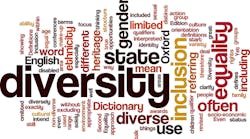A majority of big companies say gender and racial diversity are key factors in picking a new director. Fewer than half are willing to show whether they are succeeding.
About 45% of companies disclose the gender of directors and about 40% reveal the race or ethnicity, according to a detailed analysis of the regulatory filings of 500 of the largest U.S.-listed public companies by Equilar.
That’s less than the over 60% that say each of those factors is important in picking board members, according to the study released on Sept. 13.
“There is no standard” for how companies disclose such information, said Matthew Goforth, Equilar senior governance adviser and one of the study’s authors. “But if that were to happen, that would put more pressure on boards to diversify if they were perceived as being less diverse.”
Institutional investors such as State Street Global Advisors and BlackRock Inc. are pressuring boards to add women as directors and are more likely than in the past to support shareholder proposals that call for better disclosure of diversity. Lacking federal requirements, such as those for disclosing director pay, the way companies are presenting the information varies widely.
Women lost ground on new board seats for the first time in eight years last year, taking just under 28% of the 431 open board seats in Fortune 500 companies, according to executive recruiter Heidrick & Struggles.
The number of people of color appointed as directors fell in 2016 and the rate of minorities serving on boards has been mostly unchanged over the last decade, according to executive recruiter Spencer Stuart.
The desire for more information exposes some of the difficulty in presenting it, Goforth said. Gender is more readily apparent than race, which more often than not requires the director to self-identify, he said. Where even a picture might let an investor determine gender, it can be less reliable for race or ethnicity, Goforth said. Also, in different countries, racial and ethnic diversity have different meanings where gender doesn’t, he said.
Some companies disclose the overall diversity of their board while others give the information for each director individually, Equilar found. The information is often in a chart or graphic, making it more difficult to find with keyword searches. Using one such search last year, an Equilar study found that only 13% of companies in the S&P 500 disclosed diversity in ways that were evident in the text.
Increasingly, the evidence is that diversity leads to better financial return and investors are pushing the business case, Goforth said. In a 2015 study, McKinsey found that companies with above-average gender equity are 15 percent more likely to outperform markets than those who lag the average. Last year, a Credit Suisse report determined that companies with a more diverse workforce return more money to investors.
Different boards see diversity in different ways -- for example, some may consider geographic diversity, age, experience and skills in finance or cybersecurity -- adding to the complexity of reflecting the board makeup, Goforth said. If a standard is developed, it would likely have to let directors to describe their own race and gender, because there would be too much resistance to any sort of external designation.
"Ultimately, investors want to avoid the board becoming an echo chamber of 8-12 people sitting in a room," Goforth said.
By Jeff Green



